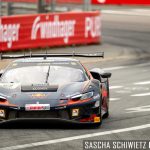The DTM, short for Deutsche Tourenwagen Masters, is one of Europe’s best-known racing series. Originally launched in the 1980s as a touring car championship, it has gone through several big changes over the decades. Today, DTM features GT3-spec cars from top manufacturers and delivers fast-paced, no-nonsense sprint racing. Here’s how it works.
What Is the DTM?
The DTM began in 1984 as a German touring car series. It grew into a high-tech championship with custom-built cars before being restructured in the 2000s. In 2021, the series switched to GT3 regulations, meaning the same base cars used in endurance races like the Spa 24 Hours and Nürburgring 24 Hours.

In 2023, the DTM came under the control of the ADAC, the same body that runs GT Masters and other German motorsport events. Today’s DTM offers a sprint-race format focused on pro drivers, aggressive racing, and strong manufacturer involvement. Boiled down to its essence, modern DTM is touring car racing with exotic GTs.
The 2025 season features nine manufacturers, the highest number since 1987, including newcomers Aston Martin and Ford. The grid is packed with talent—former champions, race winners, and even ex-Formula 1 drivers like Timo Glock. This makes the DTM one of the most competitive GT3 sprint series anywhere in the world.
Race Format
Each DTM race weekend includes two sprint races: one on Saturday, one on Sunday. Each race lasts about 55 minutes plus one lap, with no driver changes. From 2025 onward, Sunday races require two mandatory pit stops, while Saturday races continue with one.
Pit stops are for tyre changes only—refuelling is not allowed. Importantly, tyre changes during a full-course yellow or safety car period do not count as a mandatory stop. Pit strategy, timing, and execution are all critical to success.

Drivers who qualify in the top 10 must start the race on the same tyres they used in qualifying. This tyre rule adds a strategic element, especially regarding tyre degradation and warm-up.
Each weekend begins with free practice sessions: 55 minutes for FP1 and 45 minutes for FP2. These replace previous Thursday test days and give teams time to dial in their setups under testing restrictions.
The grid is set by qualifying sessions held before each race, with pole position worth extra championship points. The condensed format and short race lengths keep the action tight and the field closely matched.
Cars and Regulations
Cars in the DTM are built to GT3 specs and come from a wide range of manufacturers, including:
- Audi (R8 LMS GT3)
- BMW (M4 GT3 Evo)
- Mercedes-AMG (GT3 Evo)
- Porsche (911 GT3 R)
- Lamborghini (Huracán GT3 Evo2)
- Ferrari (296 GT3)
- McLaren (720S GT3 Evo)
- Aston Martin (Vantage GT3)
- Ford (Mustang GT3)

The cars are balanced through Balance of Performance (BoP), usually determined by the SRO/ADAC in cooperation with manufacturers. This ensures that all cars, despite different engine types and layouts, can compete on a level playing field.
Unlike in the GT World Challenge, the DTM does not use FIA driver ratings. That means no Pro-Am or Am categories—just drivers racing head-to-head.
Drivers and Teams
DTM fields a mix of factory-supported entries and private teams, but nearly all the drivers are experienced professionals. Big names from GT3, endurance racing, and even former F1 drivers often appear.
Most teams run one or two cars. Some manufacturers back their teams heavily with engineers, drivers, and budget, while others support from a distance. The lack of driver changes makes DTM more about individual driver performance.
Points and Championships
The DTM awards points to the top ten finishers in each race, similar to Formula 1:
Race Points:
- 1st: 25 points
- 2nd: 18 points
- 3rd: 15 points
- … down to 10th: 1 point
Qualifying Points:
- 3 points for pole position
- 2 points for P2
- 1 point for P3
There are championship titles for Drivers, Teams, and Manufacturers.

Why the DTM Matters
The DTM is one of the most prestigious national racing series, with a legacy that includes stars like Bernd Schneider, Dario Franchitti, and Gary Paffett. Even with the move to GT3, it maintains its identity as a driver-focused sprint series.
It differs from endurance-focused series by keeping races short, aggressive, and strategic, with pit stops and qualifying playing a huge role. Its pro-focused format and tight rules attract top-tier talent.
Under ADAC control, DTM continues to evolve, sometimes overlapping with GT Masters or attracting the same teams. But it remains a unique stage for GT3 cars to shine in a pure sprint setting.
Whether you’re watching from the grandstands at the Lausitzring or following online, the DTM delivers some of the most intense GT racing in Europe. Follow all the latest DTM action on GT REPORT and check out our detailed 2025 DTM entry list now available on our website.

Love what we do? Support GT REPORT with a donation and fuel our next trip to the racetrack.
Even €5 makes a difference!

















